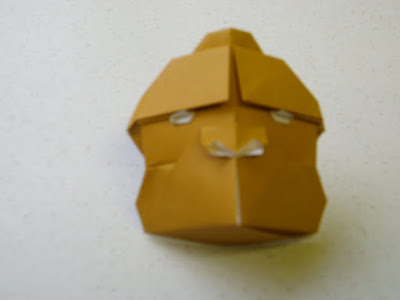skip to main |
skip to sidebar









 After the baptism-of-fire of Ted Norminton's more advanced folding, I decided my next major project would be to work through another book by Kunihiko Kasahara. This time, it's his "Origami Omnibus", which has been recommended on many of the Origami websites I've scanned. The photos I've uploaded here are mostly from the first main section, which concerns masks of various kinds. One or two of the photos are a bit blurry, because I folded all the masks from 15cm paper, which meant some of the masks turned out very small. The masks are, in order: Celestial General, Gorilla, Kamui, Lion (Male) Mane, Monster from the Arabian Nights, and Tengu. Next come a couple of modular figures (my first foray into this area, which looks fascinating, and will appeal to my mathematical tendencies): Jumbo Unit Spinning Top (2 views) and Multiunit Decorative Sphere. Finally, there's a photo of the very first model in Tomoko Fuse's classic "Unit Origami" book. When I eventually finish with "Origami Omnibus", Fuse's book will be my next project, but I couldn't resist trying just one model from her book, so the last photo in this set is her Cube - Small Square-Pattern Belt Unit. Hope you enjoy some of them.
After the baptism-of-fire of Ted Norminton's more advanced folding, I decided my next major project would be to work through another book by Kunihiko Kasahara. This time, it's his "Origami Omnibus", which has been recommended on many of the Origami websites I've scanned. The photos I've uploaded here are mostly from the first main section, which concerns masks of various kinds. One or two of the photos are a bit blurry, because I folded all the masks from 15cm paper, which meant some of the masks turned out very small. The masks are, in order: Celestial General, Gorilla, Kamui, Lion (Male) Mane, Monster from the Arabian Nights, and Tengu. Next come a couple of modular figures (my first foray into this area, which looks fascinating, and will appeal to my mathematical tendencies): Jumbo Unit Spinning Top (2 views) and Multiunit Decorative Sphere. Finally, there's a photo of the very first model in Tomoko Fuse's classic "Unit Origami" book. When I eventually finish with "Origami Omnibus", Fuse's book will be my next project, but I couldn't resist trying just one model from her book, so the last photo in this set is her Cube - Small Square-Pattern Belt Unit. Hope you enjoy some of them.



 For those idle moments during this year's annual holiday in Cornwall, I took along a pack of paper and the two booklets of folds by Ted Norminton from the British Origami Society. "Sink Or Swim" was tough enough, but "Petal Folds and More" made me feel as if my fingers were breaking and my brain melting. Still, I managed a half-reasonable stab at several of the figures, and Janet took the photographic evidence. I left the figures on the bookshelves at our holiday cottage for the next occupants to discover. Wonder if they realised the toil and torment that went into them?
For those idle moments during this year's annual holiday in Cornwall, I took along a pack of paper and the two booklets of folds by Ted Norminton from the British Origami Society. "Sink Or Swim" was tough enough, but "Petal Folds and More" made me feel as if my fingers were breaking and my brain melting. Still, I managed a half-reasonable stab at several of the figures, and Janet took the photographic evidence. I left the figures on the bookshelves at our holiday cottage for the next occupants to discover. Wonder if they realised the toil and torment that went into them?
One recurring problem I had with Ted's creations was the whole area of sinks.It gradually dawned on me that I'd not really grasped the distinction between open sinks and closed sinks - let alone such niceties as half-closed sinks, and closed/open unsinks. Time and again, the next step in a diagram would show the figure-in-progress with four pouch-like pockets arranged radially, whereas I had eight separate vanes flapping about. After the holiday, I did some serious Googling on the subject of sinks, and spent several evenings just practising putting closed and open sinks into a waterbomb base until I started to understand the distinction from a geometric point of view, as well as from a practical point of view. I was horrified to learn that a closed sink often inevitably involves making quite a mess of part of the model, and then tidying it up. I'd been thinking of Origami as always very neat and precise, but obviously I need to learn to be unafraid to allow things to get messy sometimes.













